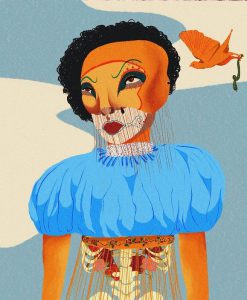
“The Mask I Give Myself” by Luke Manning
by Nat Raum
If you’ve ever looked at a journal’s submission form and felt fear strike your heart when they’re asking for a cover letter, you’re not alone. In fact, this kind of professional writing is a somewhat elusive skill that most people learn through practice—there aren’t a lot of classes out there on how to write a cover letter, artist statement, or bio. I’ll break down some of the skills I’ve picked up not only as an editor, but as an artist and writer submitting my own work.
1. Get to the point.
This might sound harsh, but hear me out when I tell you why it’s also practical advice: the idea of the cover letter is to sell your work as succinctly as possible. Start with a salutation (“Dear [Journal] editors,” is a good catch-all) and introduce yourself right away. Who are you? What does your creative background look like? Maybe you’re a current writing student, or your paintings were exhibited at a local venue. Maybe you have a lengthy or impressive publication history you want to mention. If you don’t have as much experience, a simple statement about what you do also works.
2. Tell us what we’re reading.
Maybe you’ve submitted a short story, several poems, or a piece that hops between genres—let us know! Is it part of a larger collection? Was it submitted simultaneously? Also consider if there’s any other context the editorial team might need to consider—maybe the piece is in response to a work of art, or maybe you’ve been inspired by current events. But don’t go on forever! It’s also important that the work still speaks for itself.
3. Read the room.
Different journals have different expectations. Some journals do expect a more formal cover letter, but others want to see you pull your personality into it! If there’s no guidelines listed for what to include in your letter, it’s safe to assume you should write a more standard letter. Don’t be afraid to be yourself, though! You might be published in the New Yorker, but maybe you also host a youth art workshop in your spare time or regularly perform at open-mic nights. Maybe your day job in a medical lab isn’t necessarily related to creativity, but it informs your work.
4. Put the finishing touches on.
This includes proofreading, but it also includes making sure you’ve followed all of the guidelines. Some editors will still look at submissions that do not follow guidelines, but some will discard them unread, which puts all of your hard work to waste. Make sure you’ve included all
information that the journal has requested in your cover letter and that your submitted work follows any length and other formatting guidelines.
5. Follow up—when appropriate.
Be sure to keep track of your submissions and follow up if you need to. You should always let journals know as soon as you’re able if a simultaneously submitted work is no longer available. Additionally, pay attention to a journal’s estimated response times. It’s appropriate to query after that time has passed, but try to hold off on following up on the status of your work until it’s outside of that window.
Now you’re ready to get your work out there with the confidence of a fabulous cover letter! Happy submitting, and good luck!
